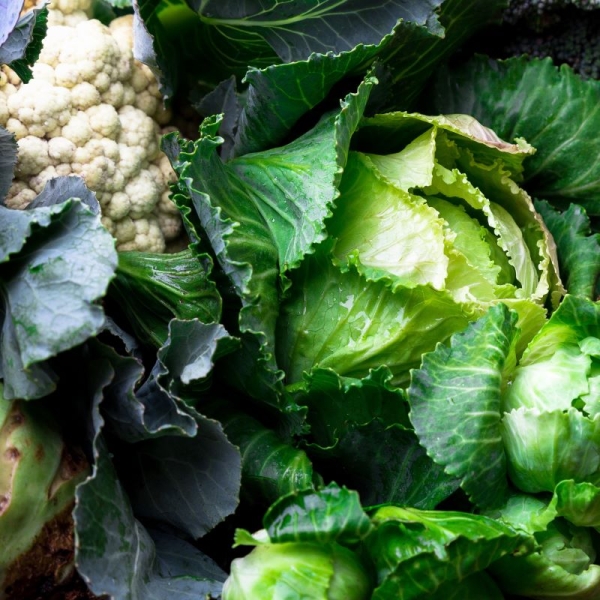05 Sep 2024 — Increased consumption of cruciferous vegetables lowers blood pressure better than root and squash vegetables, according to a crossover trial. After two weeks of consuming around 300 g daily of these vegetables (e.g., broccoli, cabbage, cauliflower and kale), participants reduced their systolic blood pressure by 2.5 mmHg, which the researchers state is “clinically relevant.”
The researchers note that increased consumption of various vegetables has many health benefits due to the presence of vitamins, minerals and other bioactive compounds. The study’s outcomes align with earlier research on the cardio-protective properties of glucosinolates and isothiocyanates, compounds found in cruciferous vegetables.
Nutrition Insight discusses the study’s outcomes and implications for dietary recommendations with Emma Connolly, Ph.D candidate and the study’s first author, and senior author Dr. Lauren Blekkenhorst, National Health and Medical Research Council of Australia emerging leadership fellow and National Heart Foundation of Australia postdoctoral research fellow. They are researchers at the Nutrition and Health Innovation Research Institute at Edith Cowan University, Australia.
“A 2.5 mmHg reduction in blood pressure can translate to roughly 5% lower risk of experiencing a major cardiovascular disease event, such as a heart attack or stroke,” they explain.
“Our study results suggest targeted strategies to increase cruciferous vegetable intake may lead to reducing the substantial burden cardiovascular disease has on our communities.”
Dietary interventions
For the randomized, controlled, crossover trial, the researchers recruited 18 participants with mildly elevated blood pressure (systolic blood pressure of 120–160 mmHg). The group completed two two-week dietary interventions, separated by a two-week washout.
The research team measured 24-hour brachial ambulatory systolic blood pressure before and after each intervention. The results are published in BMC Medicine.
Participants consumed around 300 g of cruciferous vegetables or root and squash vegetables daily. They received soup containing these vegetables, prepared at Edith Cowan University, which they consumed with lunch and dinner for two weeks. The individuals did not know which of these interventions was the “active” or “control” soup.

The cruciferous vegetable soup contained 40% broccoli, 25% cauliflower, 25% cabbage and 10% kale.The study details: “The active soup contained 40% broccoli, 25% cauliflower, 25% cabbage and 10% kale, and the control soup contained 40% potato, 30% pumpkin, 20% carrot and 10% sweet potato.”
For both interventions, 72% of participants had a 100% adherence, measured with food diaries and biomarkers.
Connolly and Blekkenhorst highlight: “Background diet and lifestyle remained consistent throughout the study, indicating the blood pressure lowering effects seen were not influenced by these factors.”
The researchers provided participants standard lunch and dinner meals to minimize background diet variation. These provided 75–450 g of vegetables daily, excluding the additional vegetables provided in the soups.
Heart-healthy vegetables
Cardiovascular diseases remain one of the leading causes of death worldwide, spurring research into healthy diets and nutraceuticals for heart health.
According to the authors, cruciferous vegetable intake has been associated with lower cardiovascular disease risk in observational studies. However, Connolly and Blekkenhorst explain that there are “limited randomized controlled trials investigating the effects of cruciferous vegetables on risk factors for cardiovascular disease, such as elevated blood pressure.”
Their study adds to the existing evidence base, “supporting that cruciferous vegetables have superior cardiometabolic health benefits compared to some other vegetable types.”
Meanwhile, they observe that cruciferous vegetables “typically only make up a small portion of total vegetable intake.”
“As this study has shown that cruciferous vegetables (broccoli, cabbage, cauliflower, kale) can result in improved blood pressure compared to root and squash vegetables (carrot, potato, pumpkin, sweet potato), we hope that this can help encourage people to include more cruciferous vegetables into their meals and snacks as part of a heart-healthy diet.”
Meanwhile, another study found that molecules in cruciferous vegetables can help maintain a healthy lung barrier and ease infection.

Cruciferous vegetables contain several compounds, vitamins and minerals that may help lower blood pressure.Beneficial compounds
The researchers explore several potential explanations for the cardio-protective benefits of cruciferous vegetables. For example, they found higher levels of plasma sulforaphane after consuming cruciferous vegetables for two weeks, indicating that glucosinolates were present in the soup.
“Interestingly, cruciferous vegetables contain compounds that can be found almost exclusively in these vegetables, including glucosinolates. These compounds have been shown to lower blood pressure in animal studies, but more evidence is needed in humans,” adds Connolly and Blekkenhorst.
Additionally, they used S-methyl cysteine sulfoxide as a biomarker for cruciferous vegetable intake, which increased after the active dietary intervention. Meanwhile, this biomarker has also been identified as a critical metabolite associated with the antihypertensive benefits of the Dietary Approaches to Stop Hypertension (DASH) diet.
Both S-methyl cysteine sulfoxide and glucosinolates may be partly responsible for the reduction in blood pressure observed. However, the research team underscores that these vegetables also contain other compounds that may impact blood pressure.
Connolly and Blekkenhorst illustrate: “Cruciferous vegetables also contain many other nutrients and other bioactives compounds that likely have a synergistic effect in lowering blood pressure and improving blood vessel health including nitrate, flavonoids, vitamin K, vitamin C, potassium, magnesium, folate and fibers.”
Therefore, they conclude that they cannot fully clarify “which specific components are responsible for the beneficial effects that we observed.”
The researchers note that future research is needed to determine whether targeted recommendations to increase cruciferous vegetable intake within a healthy diet can reduce the public health burden of cardiovascular diseases.
Connolly and Blekkenhorst highlight: “Our results would need to be replicated in other populations. The results of our study included Australian adults who were middle-aged or older and were majority female and Caucasian.”
By Jolanda van Hal

